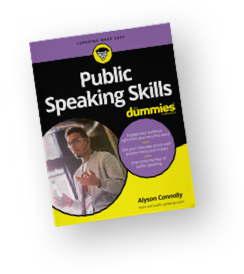Statistics show that people would rather die than speak in public. Why is that? It’s built into us. Our nervous system consists of nerves and cells that carry messages to and from our brain and spinal cord. The sympathetic nervous system activates the “fight or flight” response within our bodies while the parasympathetic nervous system, often called the “rest and digest” system, is responsible for the “freeze” response. The “fight, flight or freeze” response is the physiological reaction that occurs when someone experiences fear or anxiety. But I’m giving a speech, not slaying a dragon!
Our bodies have been connected to the “fight, flight, or freeze” response since the days of the cavemen, who were always on guard waiting for a predator like the saber-toothed tiger to attack. When we detect danger, the amygdala in our brain sends a message to the hypothalamus which is the control centre in our brain. In turn the hypothalamus sends a message to the adrenal glands which then secrete adrenaline into our blood stream. This rush of adrenaline gives us added energy so that our muscles can respond to the perceived threat. With this added energy the cave men could kill the saber-toothed tiger, run away, play dead, or freeze, and the adrenaline would subside. However if there were a pack of saber-toothed tigers which the cave men would have to battle for a long time, the adrenal glands would then secrete the stress hormone cortisol.

So, back to your speech. We need a certain amount of energy to give a presentation or a speech, so there is more adrenaline rushing through our body than when we are home watching T.V., but if we are constantly anxious when we present, our cortisol level will stay high and that’s when we have a problem.
The cave man was constantly on guard, watching and ready to defend himself from perceived threats. This habitual pattern, spending all his time in anticipation of danger, made sense because the danger was real.
Jump ahead to present day: the threat is gone but the brain still reacts quickly to negative stimuli in the absence of any real threat. Our brain has a habitual pattern in which negative thoughts impact us quickly and with more force, than positive. Think about it. We gossip about negative things, we are more likely to write a letter of complaint rather than one of thanks, and when someone tells us four positive things about ourselves and one negative, we harp on the negative comment. The brain is like Velcro for negative and Teflon for positive. But we can change. The habitual pattern in our brain can be altered to produce a more positive outlook. This ability to change is called neuroplasticity.
Tense body, shallow breathing, sweating palms, increased heart rate are all symptoms of “Flight, Fight or Freeze” response. Here are some exercises that can help:
Progressive Relaxation
This method of relaxation was devised by a doctor in the early 1930’s to help his patients with anxiety. It worked for them and it sure works for my clients.
Often people don’t realize they are holding tension in their bodies until they encounter this exercise. The complete exercise is on the website below. You either sit or lie down and tense and release certain muscle groups. Tense for 10 seconds, then release. The premise is to be aware of how the muscle group feels when they are released.
Breath
Ideally, when we breathe in, the breath should fill up our lungs. When we are fearful, we become tense and our breath rises up into our upper chest and only short breaths are taken. If you are chest breathing, you are holding tension in your chest and shoulders preventing air from going down to your lungs. You can even hyperventilate! An easy way to find out if you are breathing from your chest is to put hand on your lower abdomen and the other on your chest. On an inhale, whichever hand moves first is where you breathe first.
The Backward Circle
This is a beneficial exercise for many reasons: it drops the breath deep into the lungs, it activates the “Rest and Digest” Parasympathetic Nervous System which calms us.
Your arms are down by your sides. Move your hands in front of you and touch opposite fingertips. Pretend that you have a beach ball in front of you. When you breathe in, move your hands forward and out from your body, up and over the beach ball. On an exhale move your hands in and down to your pelvis. Try it with a count of 4 on the inhale and 4 on the exhale. You can count longer but make sure to use the same number of counts on the inhale and exhale.
“If you think you can do a thing, or you think you can’t do a thing, you’re right”
Henry Ford
Freeing the body of unnecessary tension and dropping the breath helps reduce stress levels physiologically. However, stress also affects us psychologically. Remember how our brain reacts to negatives thoughts?
The mere thought of a walking up to a lectern to present a speech creates a negative response in someone with performance anxiety. And if you think that your speech is “terrible”, “boring”, “the audience won’t like me”, you won’t change your habitual negative pattern.
Creative Visualization
This is a practice that invites the imagination to create what you want in real life. Athletes use it all the time. Olympic Gold Medalist Clara Hughes:
“When I was on the line for my 5,000 metre race, nerve and all, I would say to myself ‘seven minutes. Seven minutes and it’s over. What are you going to do for the next seven minutes’. And that was pretty much it. That put me in the mindset that this has a beginning and an end. The in between was up to me. Back to the reality that it was an opportunity, not a chore.”
Envision a successful speech; go through it in your mind. The opening, smooth transitions, and a wonderful ending that brings the audience to their feet.
Try to incorporate these tips the next time you give a speech and leave the “Fight, Flight or Freeze” response to the caveman.

